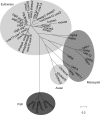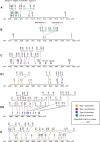Characterization of the opossum immune genome provides insights into the evolution of the mammalian immune system
- PMID: 17495011
- PMCID: PMC1899125
- DOI: 10.1101/gr.6121807
Characterization of the opossum immune genome provides insights into the evolution of the mammalian immune system
Abstract
The availability of the first marsupial genome sequence has allowed us to characterize the immunome of the gray short-tailed opossum (Monodelphis domestica). Here we report the identification of key immune genes, including the highly divergent chemokines, defensins, cathelicidins, and Natural Killer cell receptors. It appears that the increase in complexity of the mammalian immune system occurred prior to the divergence of the marsupial and eutherian lineages approximately 180 million years ago. Genomes of ancestral mammals most likely contained all of the key mammalian immune gene families, with evolution on different continents, in the presence of different pathogens leading to lineage specific expansions and contractions, resulting in some minor differences in gene number and composition between different mammalian lineages. Gene expansion and extensive heterogeneity in opossum antimicrobial peptide genes may have evolved as a consequence of the newborn young needing to survive without an adaptive immune system in a pathogen laden environment. Given the similarities in the genomic architecture of the marsupial and eutherian immune systems, we propose that marsupials are ideal model organisms for the study of developmental immunology.
Figures





References
-
- Abi-Rached L., Gilles A., Shiina T., Pontarotti P., Inoko H., Gilles A., Shiina T., Pontarotti P., Inoko H., Shiina T., Pontarotti P., Inoko H., Pontarotti P., Inoko H., Inoko H. Evidence of en bloc duplication in vertebrate genomes. Nat. Genet. 2002;31:100–105. - PubMed
-
- Altschul S.F., Madden T.L., Schaffer A.A., Zhang J., Zhang Z., Miller W., Lipman D.J., Madden T.L., Schaffer A.A., Zhang J., Zhang Z., Miller W., Lipman D.J., Schaffer A.A., Zhang J., Zhang Z., Miller W., Lipman D.J., Zhang J., Zhang Z., Miller W., Lipman D.J., Zhang Z., Miller W., Lipman D.J., Miller W., Lipman D.J., Lipman D.J. Gapped BLAST and PSI-BLAST: A new generation of protein database search programs. Nucleic Acids Res. 1997;25:3389–3402. - PMC - PubMed
-
- Baker M.L., Rosenberg G.H., Zuccolotto P., Harrison G.A., Deane E.M., Miller R.D., Rosenberg G.H., Zuccolotto P., Harrison G.A., Deane E.M., Miller R.D., Zuccolotto P., Harrison G.A., Deane E.M., Miller R.D., Harrison G.A., Deane E.M., Miller R.D., Deane E.M., Miller R.D., Miller R.D. Further characterization of T cell receptor chains of marsupials. Dev. Comp. Immunol. 2001;25:495–507. - PubMed
-
- Belov K., Deakin J.E., Papenfuss A.T., Baker M.L., Melman S.D., Siddle H.V., Gouin N., Goode D.L., Sargeant T.J., Robinson M.D., Deakin J.E., Papenfuss A.T., Baker M.L., Melman S.D., Siddle H.V., Gouin N., Goode D.L., Sargeant T.J., Robinson M.D., Papenfuss A.T., Baker M.L., Melman S.D., Siddle H.V., Gouin N., Goode D.L., Sargeant T.J., Robinson M.D., Baker M.L., Melman S.D., Siddle H.V., Gouin N., Goode D.L., Sargeant T.J., Robinson M.D., Melman S.D., Siddle H.V., Gouin N., Goode D.L., Sargeant T.J., Robinson M.D., Siddle H.V., Gouin N., Goode D.L., Sargeant T.J., Robinson M.D., Gouin N., Goode D.L., Sargeant T.J., Robinson M.D., Goode D.L., Sargeant T.J., Robinson M.D., Sargeant T.J., Robinson M.D., Robinson M.D., et al. Reconstructing an ancestral mammalian immune supercomplex from a marsupial major histocompatibility complex. PLoS Biol. 2006;4:e46. - PMC - PubMed
-
- Burt D.W. Chicken genome: Current status and future opportunities. Genome Res. 2005;15:1692–1698. - PubMed
Publication types
MeSH terms
Substances
LinkOut - more resources
Full Text Sources
Other Literature Sources
